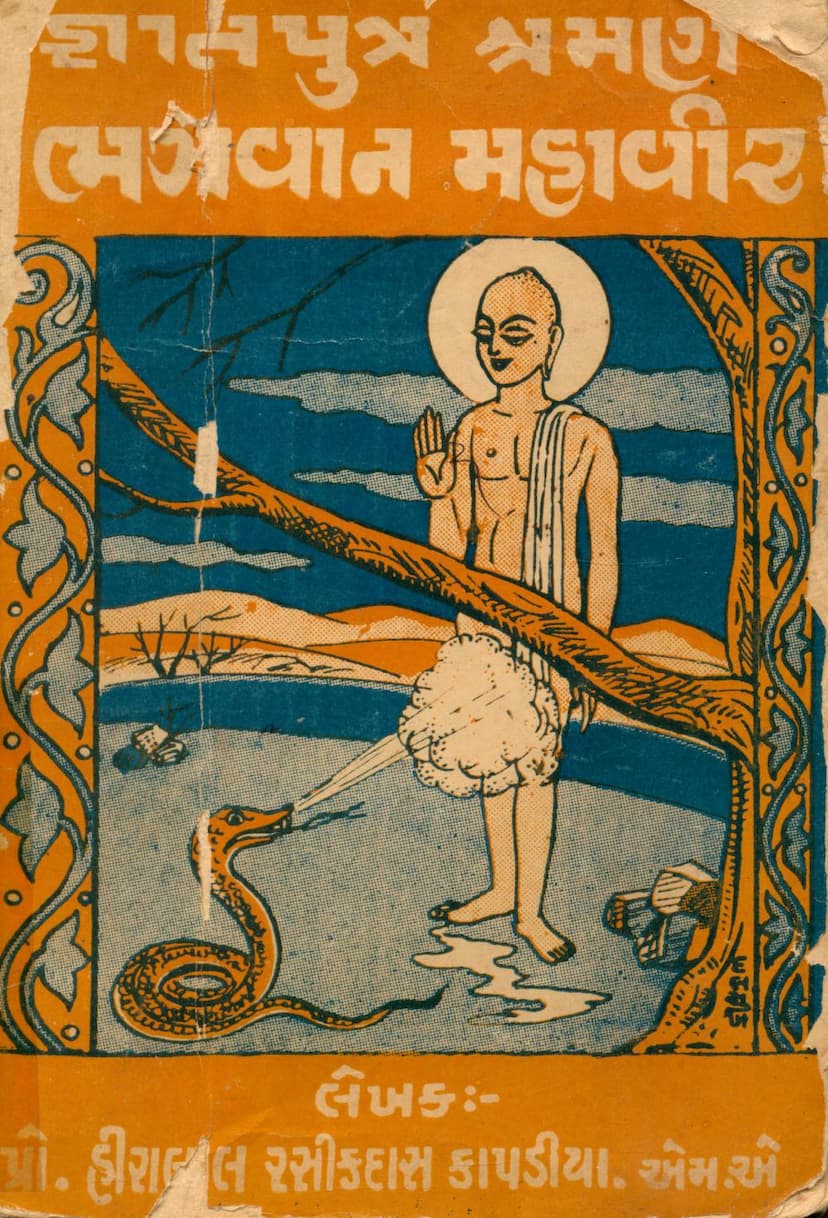Gyatputra Shraman Bhagwan Mahavir
Added to library: September 1, 2025

Summary
Here's a comprehensive summary of the Jain text "Gyatputra Shraman Bhagwan Mahavir" by Hiralal R Kapadia, based on the provided pages:
This book, "Gyatputra Shraman Bhagwan Mahavir," is a compilation of writings, dialogues, speeches, and eulogies related to Lord Mahavir by the renowned Jain scholar Professor Hiralal Rasikdas Kapadia. Published by Shri Nemi-Vigyan-Kasturi-Gyanmandir in Mumbai, it was released in Vikram Samvat 2025 / Veer Samvat 2495 / 1969 CE. The publication is motivated by the upcoming 2500th anniversary of Lord Mahavir's Nirvana.
The publisher notes that many individuals today lack the time or knowledge of Sanskrit and Prakrit to read extensive ancient texts. Therefore, they have presented the work of Professor Kapadia, who has authored approximately 180 books and over a thousand articles.
Key Themes and Content:
The book covers a wide range of topics related to Lord Mahavir and the Tirthankaras in general. Professor Kapadia's contributions are presented in various forms, including:
- Detailed descriptions of the Tirthankaras: This includes their emblems (lāñchana), characteristics (lakṣaṇa), and various forms of spiritual and physical prowess (vibhūti), with a particular focus on Lord Mahavir.
- Lord Mahavir's life and teachings: The book delves into his life events, his spiritual journey, his encounters, and his ultimate attainment of Kevaljnana.
- Philosophical discourse: It explores key Jain principles and concepts.
- Eulogies and prayers: The book includes various hymns and poetic tributes to Lord Mahavir.
- Historical and textual analysis: Professor Kapadia's work often cites and analyzes various Jain scriptures and their interpretations, providing references to specific pages for his arguments.
Highlights and Special Features:
- First publication of a translation of Sudharma Swami's eulogy: The book features Professor Kapadia's translation of the ancient eulogy of Lord Mahavir by Sudharma Swami, his primary disciple and first Ganadhar, rendered in Magadhi.
- Scholarly approach with textual citations: Professor Kapadia supports his arguments and statements by referencing numerous Agamic and non-Agamic Jain texts, often providing page numbers for crucial excerpts.
- Comprehensive scope: The book is structured to provide a thorough understanding of Lord Mahavir, starting with the characteristics of all Tirthankaras and then focusing specifically on Mahavir.
- Inclusion of Professor Kapadia's other works: Parts of the book are drawn from Professor Kapadia's previously published articles in various Jain periodicals, with acknowledgments to the editors and publishers.
- Emphasis on scholarly research: Professor Kapadia's research is highlighted by his detailed appendices, including a list of sources used in the preparation of the text.
- Inspiration from spiritual guides: The publication of this work was inspired by Upadhyaya Shri Chandrodayvijayji Gani.
Structure of the Book (indicated by the Table of Contents):
The book is divided into numerous chapters and sections, covering a vast array of details. Some of the key topics include:
- Tirthankaras' Emblems and Characteristics: Detailed discussion of the symbols and attributes of the Tirthankaras.
- Prowess of the Tirthankaras: Exploration of their spiritual and physical powers and glories.
- Eight Primary Attributes (Pratihārya): These are considered divine manifestations associated with Tirthankaras.
- Minor and Major Auspicious Signs (Atiśaya): Discussions on the various physical and spiritual marks of a Tirthankara.
- Lord Mahavir's Lives (Bhavas): An examination of his various incarnations and the relatives he had in those lives, including his twenty-seven significant lives.
- Lord Mahavir's "Tridandi" Incarnations: A focus on seven specific lives where he followed the "Tridandi" path.
- Lord Mahavir's Past Enemies: Identification and discussion of adversaries from his previous lives.
- Lord Mahavir's Physical Prowess: Detailed descriptions of his physical attributes and divine manifestations.
- Lord Mahavir's Worldly Aspect: Exploration of his life as a householder and his family relationships.
- Debate on Lord Mahavir's Marital Status: Addressing the question of whether he remained unmarried according to Shvetambara tradition.
- Lord Mahavir's Vow of Monastic Observance (Varshavas): Details about his periods of retreat during the rainy season.
- Lord Mahavir's Life of Austerity: Descriptions of his intense penances and spiritual practices.
- Lord Mahavir's Spiritual Peak: The highest points of his ascetic practices and achievements.
- Lord Mahavir's Unique Qualities: Highlighting his specific virtues and characteristics.
- Goshalaka's Eulogy: An exploration of how even an adversary like Goshalaka recognized and praised Mahavir's virtues.
- Divine Teachings (Deva ki Deshna): Explaining the nature of the sermons delivered by Mahavir.
- Lord Mahavir as the Unique Adherent and Preacher of Ahimsa: A focus on his central message of non-violence.
- Lord Mahavir's Birth Anniversary: Celebrating the auspicious occasion of his birth.
- The Birth Anniversary of the Last Jin-eshvara: A special focus on the birth of Lord Mahavir.
- A Comprehensive Account of Shraman Bhagwan Mahavir: Providing a holistic view of his life.
- A Concise Account of Shraman Bhagwan Mahavir: A brief overview of his life.
- Vir-Stuti and its Translation: The text includes this specific eulogy and its translation.
- Odes and Hymns related to Mahavir: A collection of devotional songs and praises.
- Nirgranth-Hariyali (Poetry): A poetic depiction.
- The Necessity of a Comprehensive Text on Shraman Bhagwan Mahavir Swami: A call for further literature on the subject.
- Appendices: Including lists of sources and references.
Overall Purpose:
The book aims to make the teachings and life story of Lord Mahavir accessible to a wider audience, particularly those who may not have access to the original Prakrit and Sanskrit texts. It serves as a tribute to the great soul on the occasion of the 2500th anniversary of his Nirvana and highlights the profound philosophical and ethical insights he imparted. The publisher expresses gratitude to Professor Kapadia for his invaluable contribution.